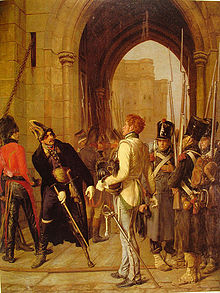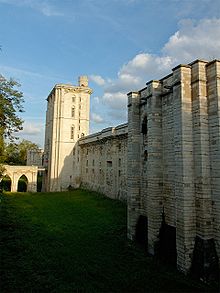- Château de Vincennes
-
Château de Vincennes Part of Vincennes Paris, France 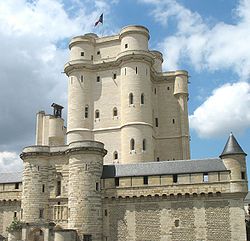
Donjon of the Château de VincennesType Medieval castle Built c. 1340-1410 Built by Charles V of France Events Hundred Years War
Battle of Paris (1814)
World War II[1]The Château de Vincennes is a massive 14th and 17th century French royal castle in the town of Vincennes, to the east of Paris, now a suburb of the metropolis.
Contents
History
Like other more famous châteaux it had its origins in a hunting lodge, constructed for Louis VII about 1150 in the forest of Vincennes. In the 13th century, Philip Augustus and Louis IX erected a more substantial manor: Louis IX is reputed to have departed from Vincennes on the crusade from which he did not return.
Vincennes was more than the grim fortress: Philippe III (in 1274) and Philippe IV (in 1284) were each married there and three 14th-century kings were born at Vincennes: Louis X (1316), Philippe V (1322) and Charles IV (1328).
To strengthen the site the castle was greatly enlarged replacing the earlier site in the later 14th century. A donjon tower, 52 meters high, the tallest medieval fortified structure of Europe, was added by Philip VI of France, a work that was started about 1337. The grand rectangular circuit of walls, was completed by the Valois about two generations later (ca. 1410). The donjon served as a residence for the royal family, and its buildings are known to have once held the library and personal study of Charles V. Henry V of England died in the donjon of dysentery in 1422 following the siege of Meaux.
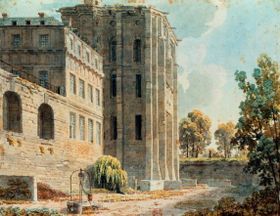 The 14th century Tour de La Reine of Vincennes from the dry moat, showing a young weeping willow marking the spot where the duc d'Enghien was executed; anonymous watercolor, ca 1820 (Bibliothèque nationale, Paris)
The 14th century Tour de La Reine of Vincennes from the dry moat, showing a young weeping willow marking the spot where the duc d'Enghien was executed; anonymous watercolor, ca 1820 (Bibliothèque nationale, Paris)
In the Château de Vincennes the relics of the Crown of Thorns were temporarily housed while the Sainte-Chapelle was being readied to receive them. A fragment that remained behind received its own chapel at Vincennes, probably built by Peter of Montereau (the probable designer of the Sainte-Chapelle in Paris), which survives (illustration, below). Henri IV spent a sojourn imprisoned at Vincennes during the Wars of Religion.
In the 17th century the architect Louis Le Vau built for Louis XIV a pair of isolated ranges mirroring one another across a parterre to one side of the keep, suited for the Queen Mother and Cardinal Mazarin, but rebuilding was never pursued once Versailles occupied all attentions. Some splendid apartments show the earliest phase of Louis XIV style, before the example of Vaux-le-Vicomte presented the Sun King with a worthy model. The unlucky builder of Vaux, the minister Nicolas Fouquet found himself transferred to Vincennes, to much less comfortable lodgings. In 1691 another unwilling lodger was John Vanbrugh, soon to become a playwright and architect, who drew some of his Baroque "gothick" from his experience of Vincennes, it has been argued.
Abandoned in the 18th century, the château still served, first as the site of the Vincennes porcelain manufactory, the precursor to Sèvres, then as a state prison, which housed the marquis de Sade, Diderot, Mirabeau, and the famous confidence man, Jean Henri Latude, as well as a community of nuns of the English Benedictine Congregation from Cambrai. At the end of February 1791 a mob of more than a thousand workers from the Faubourg Saint-Antoine, encouraged by members of the Cordeliers Club and led by Antoine Joseph Santerre, marched out to the Château, which, rumour had it, was being readied on the part of the Crown for political prisoners, and with crowbars and pickaxes set about demolishing it, as the Bastille had recently been demolished. The work was interrupted by the marquis de Lafayette who took several ringleaders prisoner, to the jeers of the Parisian workers.[2] During the remainder of the Revolution it played no part. From 1796 it served as an arms factory, suiting it to its current occupants, the historical sections of the French Armed Services. General Daumesnil who lost a leg, which was replaced by a wooden prosthesis, at the battle of Wagram was assigned to the defense of the Château de Vincennes in 1812. He faced down the allies of the Sixth Coalition marching on Paris in 1814 in the aftermath of the Battle of the Nations with the famous words "I shall surrender Vincennes when I get my leg back" (Je rendrai Vincennes quand on me rendra ma jambe, with a polysemic pun in French that is lost in translation).
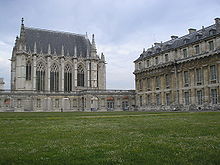 The chapel and one of Le Vau's isolated ranges
The chapel and one of Le Vau's isolated ranges
The executions of the duc d'Enghien, in 1804, and Mata-Hari, in 1917, were effected at the château. During the Nazi occupation, 30 hostages were murdered on August 20, 1944.
The park was landscaped in the English landscape style in the 19th century. In 1860 Napoleon III, having employed Viollet-le-Duc to restore the keep and the chapel, gave the Bois de Vincennes (9.95 km² in extent) and its château to Paris as a public park.
Château de Vincennes also served as the military headquarters of the Chief of General Staff, General Maurice Gamelin during the unsuccessful defence of France against the invading German army in 1940. It is now the main base of France's Defence Historical Service, which maintains a museum in the donjon.
Description of the Château
Only traces remain of the earlier castle and the substantial remains date from the 14th century. The castle forms a rectangle measuring more than a kilometer in length (330 x 175m), with six towers and three gates, each originally 42 meters high. The castle is surrounded by a deep stone lined moat. The keep, 52m high, and its enceinte occupy the western side of the fortress and are separated from the rest of the castle by the moat. The towers of the "grande enceinte" now stand only to the height of the walls, having been demolished in the 1800s, save the Tour du Village on the north side of the enclosure. The south end of the castle contains the buildings of Le Vau.
See also
- Fort Neuf de Vincennes, built to the east of the Château beginning in 1840 to provide an up-to-date artillery platform as part of the Thiers Wall defenses of Paris, now a military headquarters.
Sources
- Frank McCormick, "John Vanbrugh's Architecture: Some Sources of His Style" The Journal of the Society of Architectural Historians 46.2 (June 1987) pp. 135–144.
- Mesqui, Jean (1997). Chateaux-forts et fortifications en France. Paris: Flammarion. pp. 493 pp. ISBN 2-08-012271-1.
External links
- Website of the Château
- Information on structurae.de
- French web site about history of Castle of Vincennes, with many illustrations.
Popular visitor attractions in Paris Arc de Triomphe • Sacré-Cœur • Cathedral of Notre Dame • Centre Georges Pompidou • Champs-Élysées • Conciergerie • Eiffel Tower • Grand Palais • Jardin du Luxembourg • Les Invalides • Louvre • Musée d'Orsay • Panthéon • Opéra Garnier • Père Lachaise Cemetery • Château de Vincennes • Sainte-Chapelle Categories:
Categories:- Visitor attractions in Paris
- Châteaux in France
- Palaces in France
- Royal residences in France
- 14th-century architecture
- Buildings and structures in Val-de-Marne
- Official historical monuments of France
Wikimedia Foundation. 2010.

